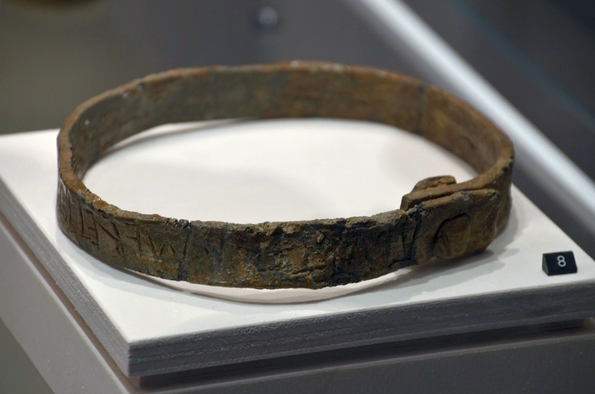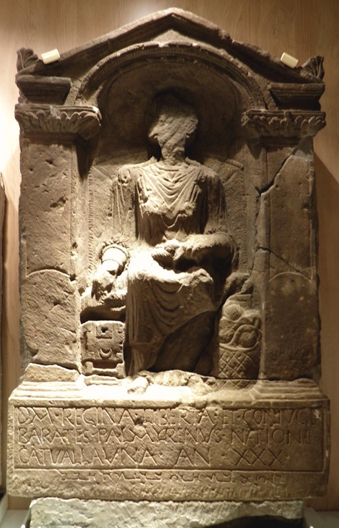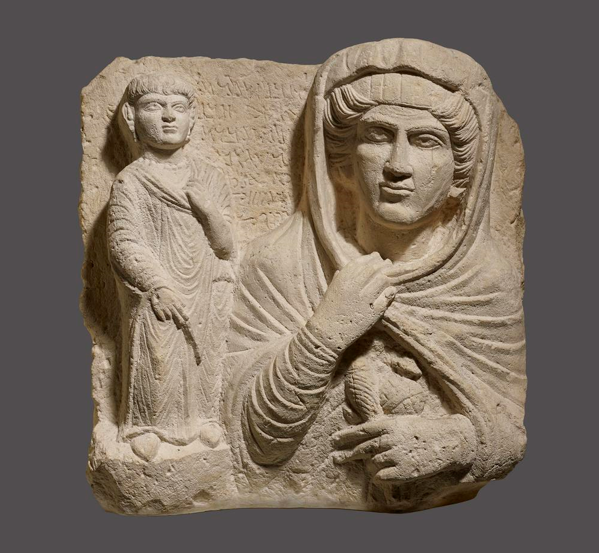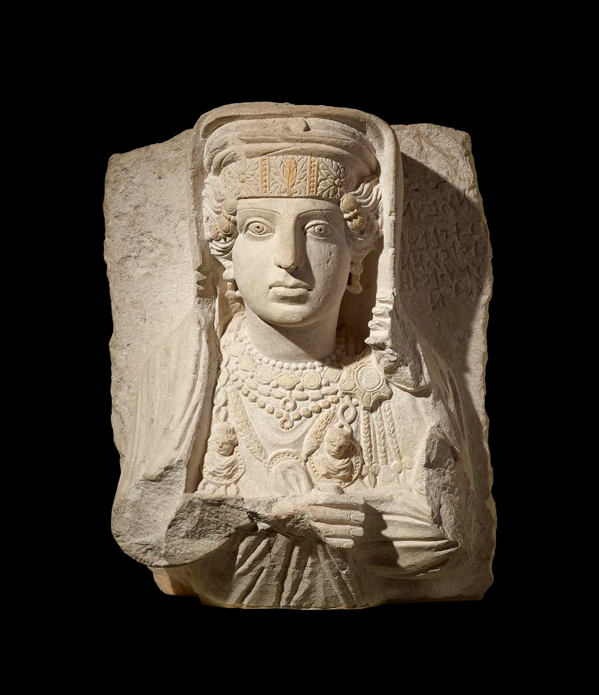Hidden in Plain Sight: The Filtered Lives of Women in the Ancient World - Katie Baldwin
In the age of social media, the lived experiences of many women are there for all to see. But the lived experiences of women in the ancient world are less obvious. Many things we see in the modern world are a filtered view of life, whether that is by an Instagram filter, a carefully chosen photo or a news article. The lived experience of women in the ancient world was heavily filtered too - not so much by Instagram, but by those who often determined how they were remembered: men. To recover the unfiltered lives of women in the ancient world, we need to look at the evidence from all angles and think about the woman behind the image. The stories of these women are hidden in plain sight, through the objects left behind in their names and the portrayals of them after their death. On International Women's Day it is important that we celebrate both those women who inspire us now, but also those women who serve as inspiration and a source of education from the past.
This blogpost will present a range of objects to uncover the stories of women who are hidden in plain sight: a slave collar from Bulla Regia in modern-day Tunisia; two funerary portraits nearly 4,000km apart; and a statue of a businesswoman from Pompeii. These objects bear witness to the lived experiences of women in all their many roles: the slave, the freedwoman, the mother, the wealthy, and the famous. Some of the topics these objects/women touch upon may be shocking, disturbing, or even upsetting, but though they may make us feel uncomfortable, we must include these women who faced hardship and tell their story too. Let us dive into constructing a picture of the lived experience of different women through the filtered objects they, or those around them, left behind.
The Bulla Regia Slave Collar (Figure 1; Tunis Musée du Bardo, ILS 9455)

Figure 1 - Slave collar found in Bulla Regia (Tunisia). Image credit: J. Lendering
This slave collar was found in 1908 in Bulla Regia, still riveted to the neck of its former owner (Merlin 1908). I feel that this object is truly an example of a woman hidden in plain sight. An object that tells us about the lived experience of a woman without us seeing the woman at all: its inscription reads “I am a slutty prostitute; retain me; I have fled from Bulla Regia” ('adultera meretrix tene quia fugivi de Bulla Regia'). We don't need to see her face to be able to construct her story. Efforts have been made to recover the identity of the wearer: her remains indicate that she was around 40 years old at the time of her death. But it is unfortunately the object itself that tells us the most about her life. The slave collar is a testament to her maltreatment and suffering, as wearing such a heavy collar would have been both physically painful and emotionally damaging. The collar shows that this woman’s life was “tightly controlled” in more ways than one (McGinn 2010: 37). We don't need to see this woman to imagine and construct a story of her life. We construct a story that shows these slaves who were maltreated, and it is important that these women are not forgotten. Their reality was a permanent slave collar as a marker of their social status. It is important we celebrate those who were less fortunate than us on International Women's Day too. She deserves to be remembered.
The Tombstone of Regina (Figure 2; TWCMS: T765)

Figure 2: The Tombstone of Regina at South Shields (UK). Image credit: C. Raddato
In contrast to the slave collar, the tombstone of Regina highlights the social progress that some women had the opportunity to make (Croom 2020). Found in South Shields in the UK, this funerary portrait shows a woman with a spindle in her lap, a basket of wool on her left and a jewellery box to her right (Hope 1997: 252). The spindle and wool symbolises her conformity to wifely duties, such as weaving (Gloyn 2012: 262), whilst the jewellery box and the items she wears shows her womanliness. These visual elements help us to build a picture of who this woman might have been and how she may have lived, although we should acknowledge that this image is very much filtered through how her husband wished to remember her.
The Latin inscription at the base reveals more about Regina’s life and her husband’s “To the spirits of the departed (and to) Regina, his freedwoman and wife, a Catuvellaunian by tribe, aged 30, Barates of Palmyra (set this up)” ('Dis Manibus Reginal liberta et coniuge Barates Palmyrenus natione Catuallaune annorum XXX'). The text reveals not only that Regina was previously a slave, but also that she was a Catuvellaunian from southeast England. Barates himself was a Palmyrene, coming from an ancient city in Syria nearly 4,000km away. Interestingly, he adds another inscription in his native language, Palmyrene Aramaic: “'Regina, the freedwoman of Barates, alas” ('rgyn’ bt hry br’t’ hbl'). Without these inscriptions, we may never have understood Regina’s or Barates’s earlier lives. But it is also important to consider what this object does not tell us: how was Regina sold into slavery, how did she meet Barates and find her freedom with him, and where did Barates’ Palmyrene identity fit into her own as a Catuvellaunian? Regina deserves to be remembered, but we must admit that this object presents only so many memories from her life.
A Palmyrene funerary portrait of Šalmat (Figure 3; BM 125150)

Figure 3 - Funerary portrait of Šalmat (originally from Palmyra, Syria; now in the British Museum, UK). Image credit: British Museum
In Barates’ home city of Palmyra, it was common to honour the deceased with funerary portraits, including many that depicted mothers with their children. Such portraits often exemplified the role of women as mothers, but it is also crucial to look beyond this gendered role and seek individual identities too. In this example, a woman, Šalmat, is accompanied by her child, but choices have also been made about her clothing and jewellery. Scholars have speculated that the cost of each relief may have affected the level of detail, which would then influence the extent of decorative elements that may tell us more about these women (Krag and Raja 2016: 135). Many other funerary portraits depict their female subjects covered in jewellery, such as one of Herta (Figure 4; BM 125019) who wears a richly decorated headband, earrings, and multiple jewelled necklaces. Šalmat, by contrast, holds simple sewing instruments (similar to Regina), wears plain clothing and seems to be adorned with no jewellery. Is this design due to cost, or reflective of Šalmat’s character? Why did she – or her family – decide to prioritise their spending on the inclusion of her child, rather than jewellery or clothing? Does it identify Šalmat’s morals, what she cared more about, or was it someone else’s decision? Similar to the Bulla Regia slave collar and the tombstone of Regina, it is important to ask questions about what we cannot see, as these hidden elements can be just as important.
Figure 4 - Funerary portrait of Herta (originally from Palmyra, Syria; now in the British Museum, UK). Image credit: British Museum (https://www.britishmuseum.org/collection/image/1613122034)
Statue of Eumachia at Pompeii (Figure 5; NM inv. 6232)

Figure 5: Statue of Eumachia at Pompeii (Italy). Image credit: R. Mortel
And finally, Eumachia at Pompeii in Italy. Eumachia came from a wealthy Pompeian family and was a public priestess (Cooley 2013). Accordingly, her statue shows the participation of a woman in civic life; a woman whose wealth and generosity allowed her to be remembered and commemorated. Eumachia funded and was remembered for the construction of several buildings to honour Augustus and his family. I think it's important we remember Eumachia as a woman who broke the norms of civic life and had influence where most other women did not. As Cooley concludes, it is not easy to judge to what extent Eumachia was an exceptional woman, but what we do know is that she highlights "the start of a process which led to the integration of women into the landscape” of Italy in the first two centuries AD (Cooley 2013: 43).
I find it particularly fascinating to think about how Eumachia's wealth influenced how she is remembered, in contrast to those women who we have already explored. The statue was in one of the structures built by Eumachia, but was consigned to the back corridor, suggesting that imperial figures were intended to be the main centre of attention. So not only was this statue set up in honour of Eumachia, a wealthy, public woman, but also she may have had some influence in where the statue was set up - I think in the context of calling this blogpost 'Hidden in Plain Sight', it is important to consider whether this was out of modesty. Eumachia exemplifies how important individuals can be in redefining the roles of women in society through their actions, an important message for International Women’s Day.
To conclude, these objects unveil a snapshot of these women. Their lives are by no means transparent, by no means understood in their entirety. However, the glimpses into their lived experience allow us to think and reflect on how they may have lived, and the extent of any ‘filtering’ of their lives. On this International Women's Day, celebrate the women who came before us, those named and nameless, seen and unseen. In the midst of the extraordinary Emmeline Pankhursts and the phenomenal Malala Yousafzais and all the other brilliant, resilient, and inspiring women we celebrate today (and everyday), there is a space for those that are often forgotten. They deserve to be remembered. Happy International Women's Day!
Bibliography
Secondary Sources:
Buttrey, T. V., (1954) "Thea Notera On Coins Of Antony And Cleopatra" in Museum Notes (American Numismatic Society), volume 6, 95-109.
Clark, G., (1981) "Roman Women" in Greece & Rome, volume 28, number 2, 193-212.
Cooley, A., (2013), 'Women Beyond Rome: Trend-Setters or Dedicated Followers of Fashion?' in Women and the Roman City in the Latin West, eds. Hemelrijk E. and Woolf G., (Brill, Leiden: Boston) 23-47.
Crook, Z., (2009) "Honor, Shame, and Social Statue Revisited" in Journal of Biblical Literature, volume 128, number 3, 591-611.
Dobbins, J. J., (1994) "Problems of Chronology, Decoration, and Urban Design in the Forum at Pompeii" in American Journal of Archaeology, volume 98, number 4, 629-694.
Gloyn, L., (2012) "She's Only A Bird In A Gilded Cage: Freedwomen At Trimalchio's Dinner Party" in The Classical Quarterly, volume 62, number 1, 260-280.
Hemelrijk, E. A., (2007) "Local Empresses: Priestesses of the Imperial Cult in the Cities of the Latin West" in Phoenix, volume 61, number 3/4, 318-349.
Hope, V., (1997) "Words and Pictures: The Interpretation of Romano-British Tombstones" in Britannia, volume 28, 245-258.
Krag, S. and Raja, R., (2016) ‘Representations of women and children in Palmyrene funerary loculus reliefs, loculus stelae, and wall paintings’ in Zeitschrift für Oriente- Archäologie, volume 9, 134-178.
McGinn, T., (2010) The Economy of Prostitution in the Roman World: A Study of Social History and the Brothel, University of Michigan Press.
Merlin, A., (1908) Le Temple d'Apollon à Bulla Regia, Getty Research Institute. https://archive.org/details/letempledapollon01merl/page/n17/mode/2up
Moeller, W. O., (1972) "The Building of Eumachia: A Reconsideration" in American Journal of Archaeology, volume 76, number 3, 323-327.
Internet Sources:
BBC, "Tombstone of a Roman Woman", last modified 24th November 2010, https://www.bbc.co.uk/ahistoryoftheworld/objects/EBvs4GUaT8Knfhl_sSpGWw, date accessed 9th September 2021.
Croom, A. (2020) ‘The Regina Tombstone’ Tyne & Wear Archives & Museums Blog. Available at: https://blog.twmuseums.org.uk/the-regina-tombstone/ (last accessed 18/2/22).
The British Museum, 'Tombstone, Copy", https://www.britishmuseum.org/collection/object/H_CRM-499, date accessed 9th September 2021.
Tyne & Wear Archives and Museum, "The Regina Tombstone", last modified 29th September 2020, https://blog.twmuseums.org.uk/the-regina-tombstone/, date accessed 9th September 2021.
